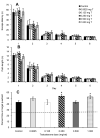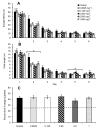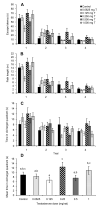Effects of testosterone on spatial learning and memory in adult male rats - PubMed (original) (raw)
Effects of testosterone on spatial learning and memory in adult male rats
Mark D Spritzer et al. Horm Behav. 2011 Apr.
Abstract
A male advantage over females for spatial tasks has been well documented in both humans and rodents, but it remains unclear how the activational effects of testosterone influence spatial ability in males. In a series of experiments, we tested how injections of testosterone influenced the spatial working and reference memory of castrated male rats. In the eight-arm radial maze, testosterone injections (0.500 mg/rat) reduced the number of working memory errors during the early blocks of testing but had no effect on the number of reference memory errors relative to the castrated control group. In a reference memory version of the Morris water maze, injections of a wide range of testosterone doses (0.0625-1.000 mg/rat) reduced path lengths to the hidden platform, indicative of improved spatial learning. This improved learning was independent of testosterone dose, with all treatment groups showing better performance than the castrated control males. Furthermore, this effect was only observed when rats were given testosterone injections starting 7 days prior to water maze testing and not when injections were given only on the testing days. We also observed that certain doses of testosterone (0.250 and 1.000 mg/rat) increased perseverative behavior in a reversal-learning task. Finally, testosterone did not have a clear effect on spatial working memory in the Morris water maze, although intermediate doses seemed to optimize performance. Overall, the results indicate that testosterone can have positive activational effects on spatial learning and memory, but the duration of testosterone replacement and the nature of the spatial task modify these effects.
Copyright © 2011 Elsevier Inc. All rights reserved.
Figures
Fig. 1
Number of (A) WME’s, (B) WRE’s, and (C) RME’s performed by castrated male rats injected daily with sesame oil (Control; N = 10) or 0.500 mg testosterone propionate (0.500 mg T; N = 8) during 5-day blocks of trials over 30 days of testing on the radial arm maze. Control males committed significantly more WME’s and WRE’s during the early blocks of trials (* P < 0.05). There was no significant difference between groups for RME’s. The difference between groups was also not significant difference between groups in (D) the latency to make the first arm choice. All data are shown as means ± SEM (N = 8/group).
Fig. 2
Performance on a reference memory version of the Morris water maze by castrated male rats injected daily for seven days with sesame oil (Control) or various doses of testosterone propionate beginning on the first day of maze testing. During six days of acquisition trials, all groups showed a significant decrease in both (A) escape latency and (B) path length (both P < 0.0005), but testosterone injections had no effect on either of these measurements of learning. (C) During probe trials, all treatment groups spent more time swimming in the target quadrant than would be expected by a random swim path (represented by dashed line), and the 0.250 mg T and 1.000 mg T groups each showed significantly better retention than the Control group (*Fisher’s LSD: P < 0.05). All data are shown as means ± SEM (N = 8/group).
Fig. 3
Performance on a reference memory version of the Morris water maze by castrated male rats injected daily for fifteen days with sesame oil (Control) or various doses of testosterone propionate beginning on the seven days before the first day of maze testing. During six days of acquisition trials, all groups showed a significant decrease in both (A) escape latency and (B) path length (P < 0.0005). For path length, but not escape latency, there was a significant day × treatment interaction (P < 0.05), and within day analyses revealed significant treatment effects for days 2 and 5 (*P < 0.05). (C) During probe trials, all treatment groups spent more time swimming in the target quadrant than would be expected by a random swim path (represented by dashed line), but there were no significant differences between groups. All data are shown as means ± SEM (N = 11-12/group).
Fig. 4
Performance during four reversal-learning trials in the Morris water maze by castrated male rats injected daily for fifteen days with sesame oil (Control) or various doses of testosterone propionate beginning on the seven days before the first day of maze testing. Reversal-learning trials were conducted on a single day after six days of acquisition trials and one day of probe trials. The platform was located in the quadrant opposite of that used for acquisition trials. All groups showed a significant decrease in (A) escape latency, (B) path length, and (C) time spent in the old target quadrant (P < 0.0005). Averaging the data across trials (D) revealed that the 0.250 mg T group spent significantly more time in the old target quadrant than did most of the other groups (letters indicate groups that differ from each other, P < 0.05). All data are shown as means ± SEM (N = 11-12/group).
Fig. 5
Escape latencies for a working memory version of the Morris water maze by castrated male rats injected daily for fifteen days with sesame oil (Control) or various doses of testosterone propionate beginning on the seven days before the first day of maze testing. Data are presented for (A) all trials, (B) averaged within trials, and (C) averaged within days. During six days of trials, all groups showed a significant decrease in escape latencies (P < 0.0005). There was also a significant day × trial × treatment interaction (P < 0.0005). Analyses within days showed a significant trial × treatment interaction for days 3 and 4 (*P < 0.05). All data are shown as means ± SEM (N = 12/group).
Similar articles
- Castration differentially affects spatial working and reference memory in male rats.
Spritzer MD, Gill M, Weinberg A, Galea LA. Spritzer MD, et al. Arch Sex Behav. 2008 Feb;37(1):19-29. doi: 10.1007/s10508-007-9264-2. Arch Sex Behav. 2008. PMID: 18058217 - Effects of testosterone dose on spatial memory among castrated adult male rats.
Wagner BA, Braddick VC, Batson CG, Cullen BH, Miller LE, Spritzer MD. Wagner BA, et al. Psychoneuroendocrinology. 2018 Mar;89:120-130. doi: 10.1016/j.psyneuen.2017.12.025. Epub 2017 Dec 29. Psychoneuroendocrinology. 2018. PMID: 29414025 Free PMC article. - Testosterone modulates performance on a spatial working memory task in male rats.
Sandstrom NJ, Kim JH, Wasserman MA. Sandstrom NJ, et al. Horm Behav. 2006 Jun;50(1):18-26. doi: 10.1016/j.yhbeh.2005.09.008. Epub 2005 Nov 2. Horm Behav. 2006. PMID: 16263125 - Testosterone modulates spatial recognition memory in male rats.
Hawley WR, Grissom EM, Martin RC, Halmos MB, Bart CL, Dohanich GP. Hawley WR, et al. Horm Behav. 2013 Apr;63(4):559-65. doi: 10.1016/j.yhbeh.2013.02.007. Epub 2013 Feb 26. Horm Behav. 2013. PMID: 23481590 - Sex-specific effects of gonadectomy and hormone treatment on acquisition of a 12-arm radial maze task by Sprague Dawley rats.
Gibbs RB, Johnson DA. Gibbs RB, et al. Endocrinology. 2008 Jun;149(6):3176-83. doi: 10.1210/en.2007-1645. Epub 2008 Feb 21. Endocrinology. 2008. PMID: 18292188 Free PMC article.
Cited by
- Effects of long term administration of testosterone and estradiol on spatial memory in rats.
Mohammadi-Farani A, Haghighi A, Ghazvineh M. Mohammadi-Farani A, et al. Res Pharm Sci. 2015 Sep-Oct;10(5):407-18. Res Pharm Sci. 2015. PMID: 26752989 Free PMC article. - Recognition memory tasks in neuroendocrine research.
Luine V. Luine V. Behav Brain Res. 2015 May 15;285:158-64. doi: 10.1016/j.bbr.2014.04.032. Epub 2014 May 13. Behav Brain Res. 2015. PMID: 24837746 Free PMC article. Review. - Testosterone Upregulates the Expression of Mitochondrial ND1 and ND4 and Alleviates the Oxidative Damage to the Nigrostriatal Dopaminergic System in Orchiectomized Rats.
Yan W, Kang Y, Ji X, Li S, Li Y, Zhang G, Cui H, Shi G. Yan W, et al. Oxid Med Cell Longev. 2017;2017:1202459. doi: 10.1155/2017/1202459. Epub 2017 Aug 24. Oxid Med Cell Longev. 2017. PMID: 29138672 Free PMC article. - Sex differences in cognition following variations in endocrine status.
Bowman R, Frankfurt M, Luine V. Bowman R, et al. Learn Mem. 2022 Sep 2;29(9):234-245. doi: 10.1101/lm.053509.121. Print 2022 Sep. Learn Mem. 2022. PMID: 36206395 Free PMC article. Review. - Chronic Swimming Exercise Ameliorates Low-Soybean-Oil Diet-Induced Spatial Memory Impairment by Enhancing BDNF-Mediated Synaptic Potentiation in Developing Spontaneously Hypertensive Rats.
Cheng M, Cong J, Wu Y, Xie J, Wang S, Zhao Y, Zang X. Cheng M, et al. Neurochem Res. 2018 May;43(5):1047-1057. doi: 10.1007/s11064-018-2515-x. Epub 2018 Mar 24. Neurochem Res. 2018. PMID: 29574667
References
- Astur RS, Ortiz ML, Sutherland RJ. A characterization of performance by men and women in a virtual Morris water maze: A large and reliable sex difference. Behav. Brain Res. 1998;93:185–190. - PubMed
- Aultman JM, Moghaddam B. Distinct contributions of glutamate and dopamine receptors to temporal aspects of rodent working memory using a clinically relevant task. Psychopharmacology. 2001;153:353–364. - PubMed
- Bartke A, Steele RE, Musto N, Caldwell BV. Fluctuations in plasma testosterone levels in adult male rats and mice. Endocrinology. 1973;92:1223–1228. - PubMed
- Beer TM, Bland LB, Bussiere JR, Neiss MB, Wersinger EM, Garzotto M, Ryan CW, Janowsky JS. Testosterone loss and estradiol administration modify memory in men. J. Urol. 2006;175:130–135. - PubMed
- Beiko J, Lander R, Hampson E, Boon F, Cain DP. Contribution of sex differences in the acute stress response to sex differences in water maze performance. Behav. Brain Res. 2004;151:239–253. - PubMed
Publication types
MeSH terms
Substances
LinkOut - more resources
Full Text Sources
Medical




